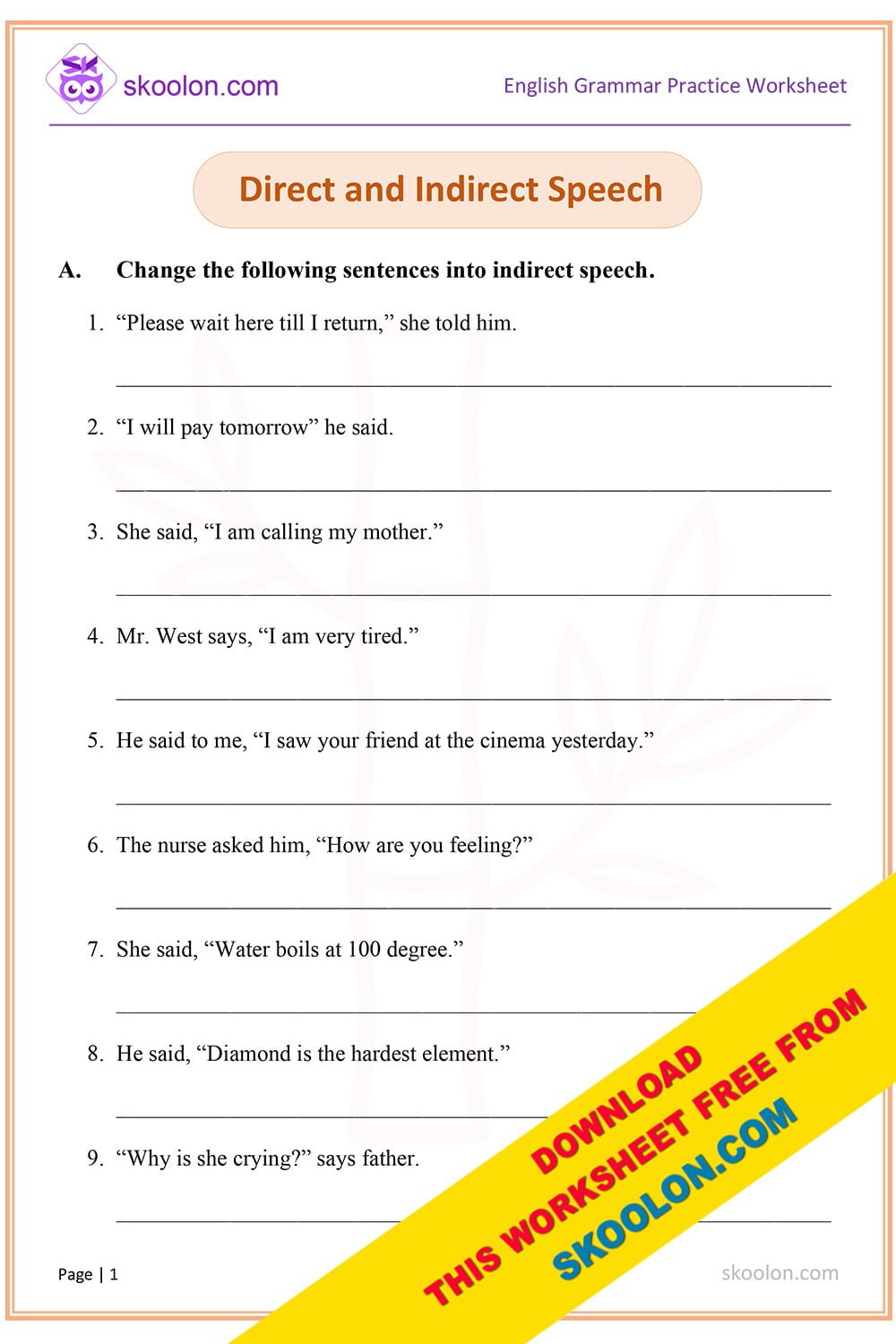
Mastering Reported Speech: The Essential Role of Direct and Indirect Speech Worksheets
In the intricate tapestry of English grammar, mastering reported speech, often referred to as direct and indirect speech, stands as a pivotal skill. It allows speakers and writers to recount what others have said without directly quoting them, a nuanced ability essential for effective communication, narrative building, and academic discourse. However, the rules governing tense changes, pronoun shifts, and alterations in time and place expressions can be daunting for learners. This is where the strategic and consistent use of Direct and indirect speech worksheets becomes not just helpful, but indispensable.
This comprehensive article will delve into the profound importance of direct and indirect speech, explore the various types of worksheets available, discuss the pedagogical benefits of their application, and offer insights into designing and utilizing these crucial learning tools to achieve proficiency.
Understanding the Core Concepts: Direct vs. Indirect Speech

Before diving into the utility of worksheets, it’s crucial to grasp the fundamental distinction between direct and indirect speech:

- Direct Speech: This involves quoting the exact words spoken by someone, enclosed within quotation marks.
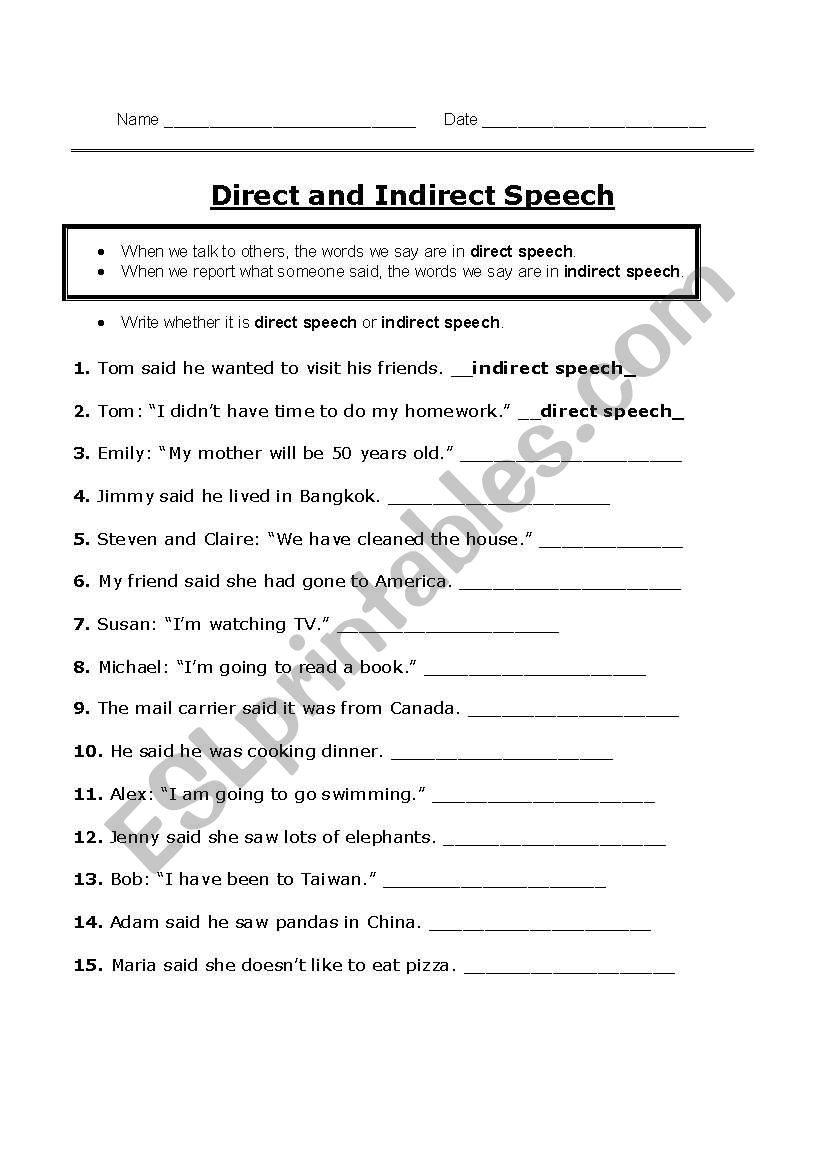
- Example: She said, "I am going to the library."
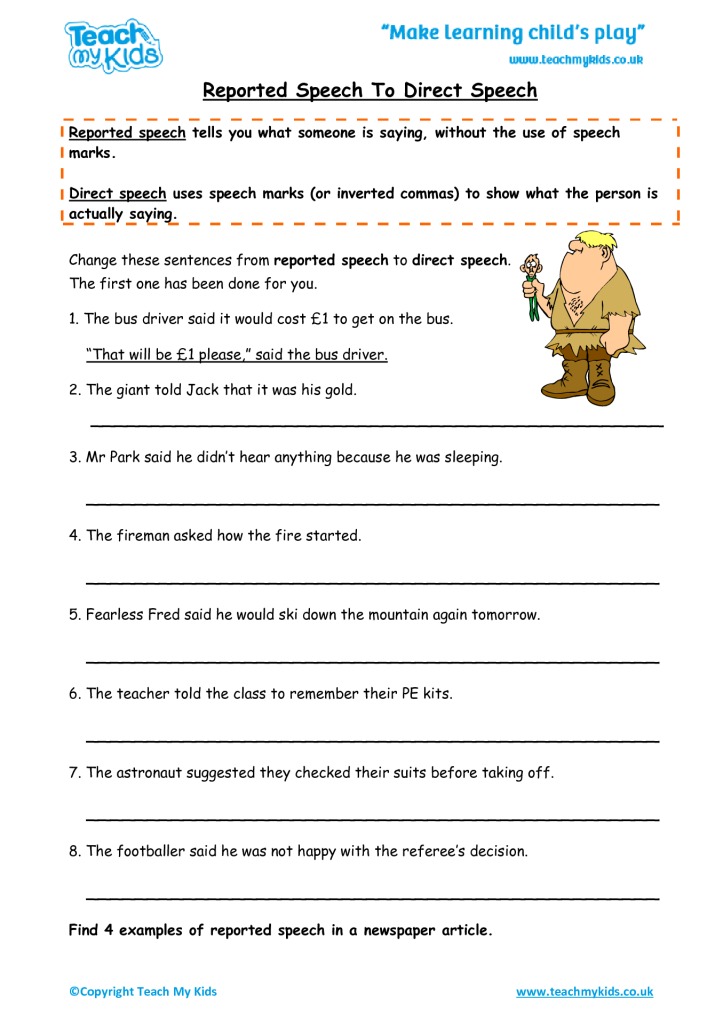
- Indirect Speech (Reported Speech): This involves reporting what someone said without using their exact words or quotation marks. It often requires changes in tense, pronouns, and time/place adverbs.
- Example: She said that she was going to the library.
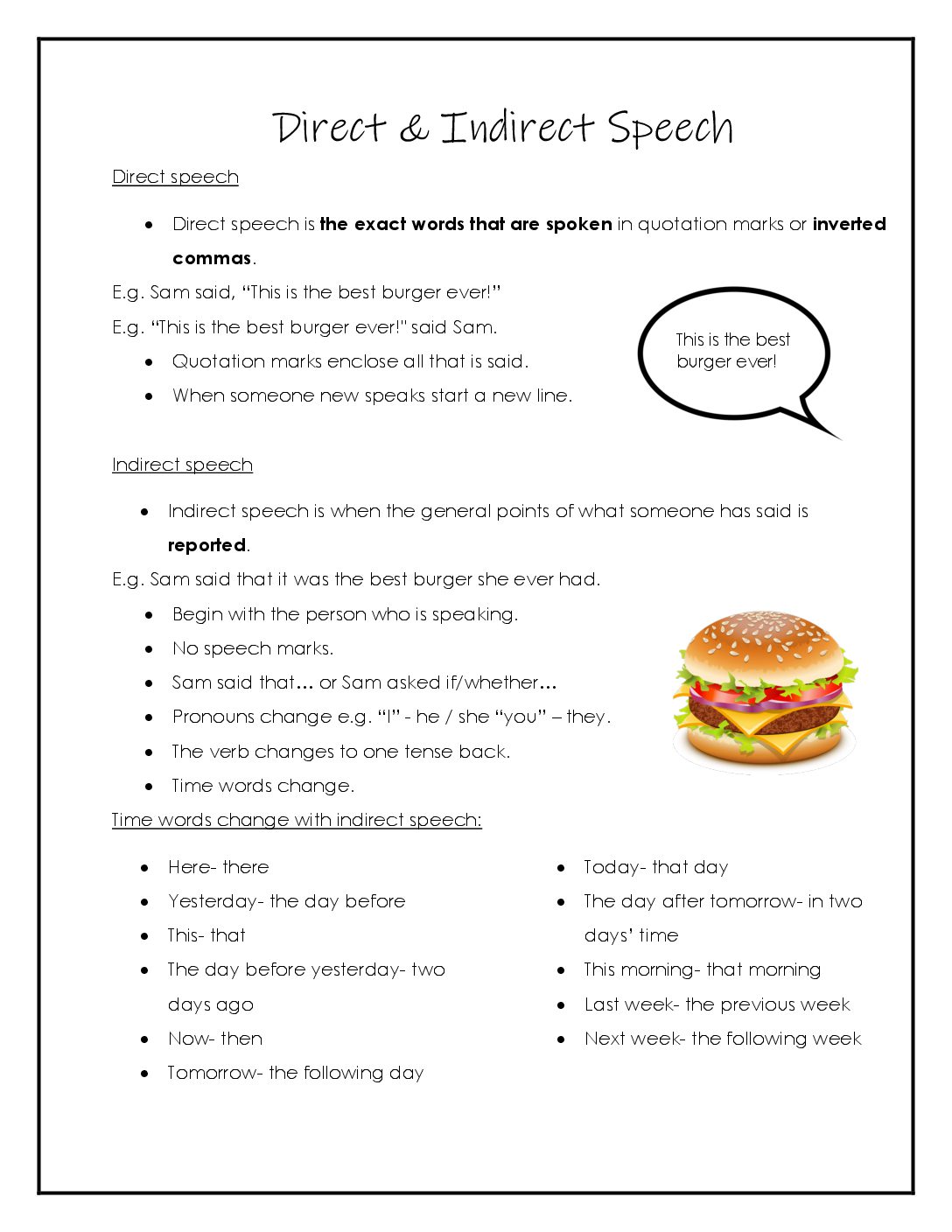
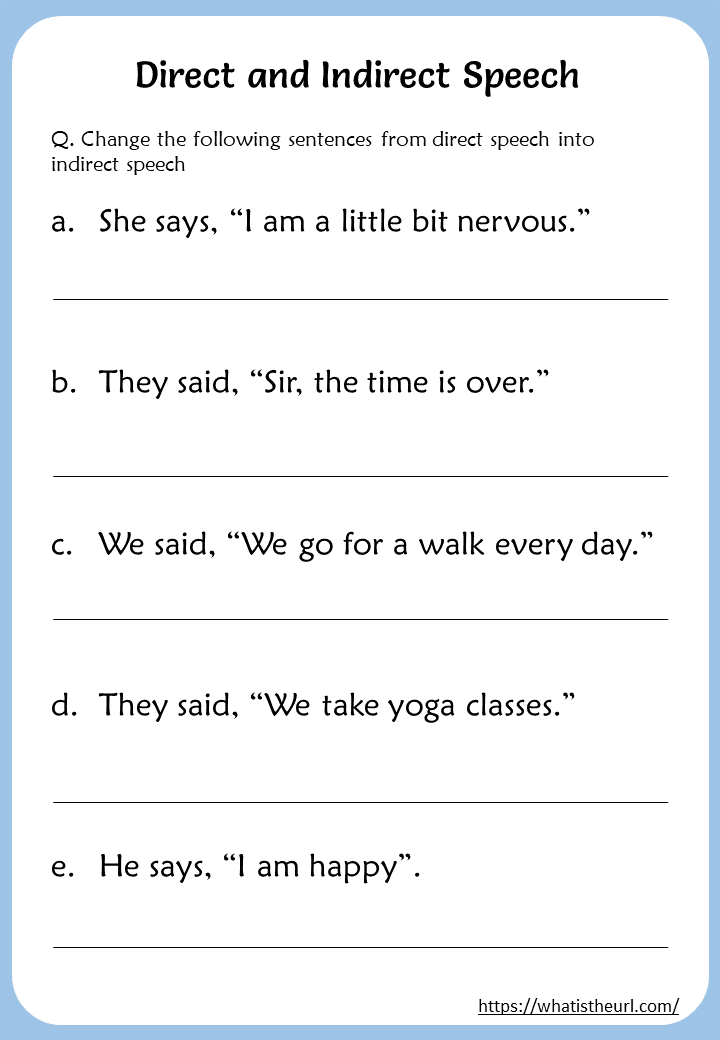
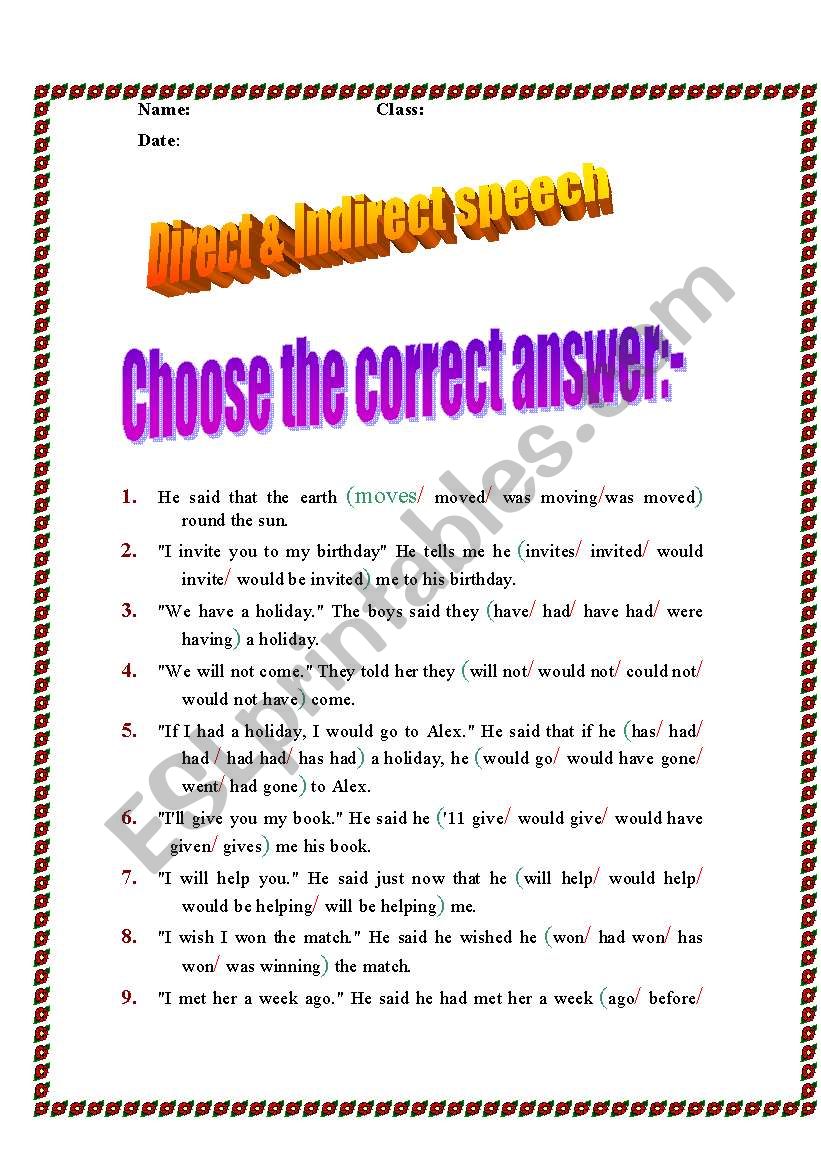
The transformation from direct to indirect speech involves several key rule sets:
- Reporting Verb: The verb used to introduce the reported speech (e.g., said, told, asked, explained).
- Tense Change (Backshift): If the reporting verb is in the past tense, the tense of the reported speech usually shifts backward (e.g., present simple to past simple, present continuous to past continuous, past simple to past perfect).
- Pronoun Change: Pronouns often change to reflect the new speaker’s perspective.
- Time and Place Expressions: Words like ‘now,’ ‘today,’ ‘here,’ ‘tomorrow,’ change to ‘then,’ ‘that day,’ ‘there,’ ‘the next day,’ respectively.
- Conjunctions: ‘That’ is often used to introduce reported statements, while ‘if’ or ‘whether’ are used for reported questions.
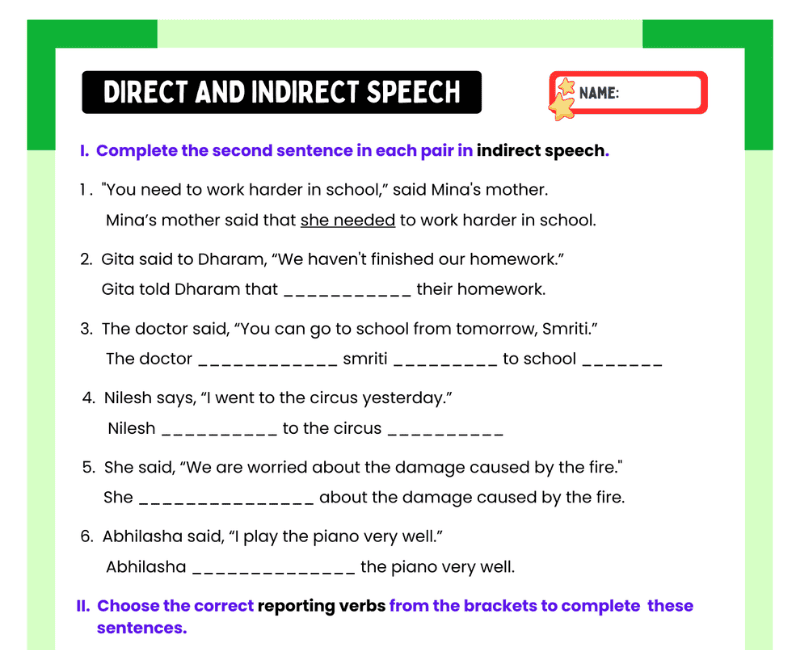
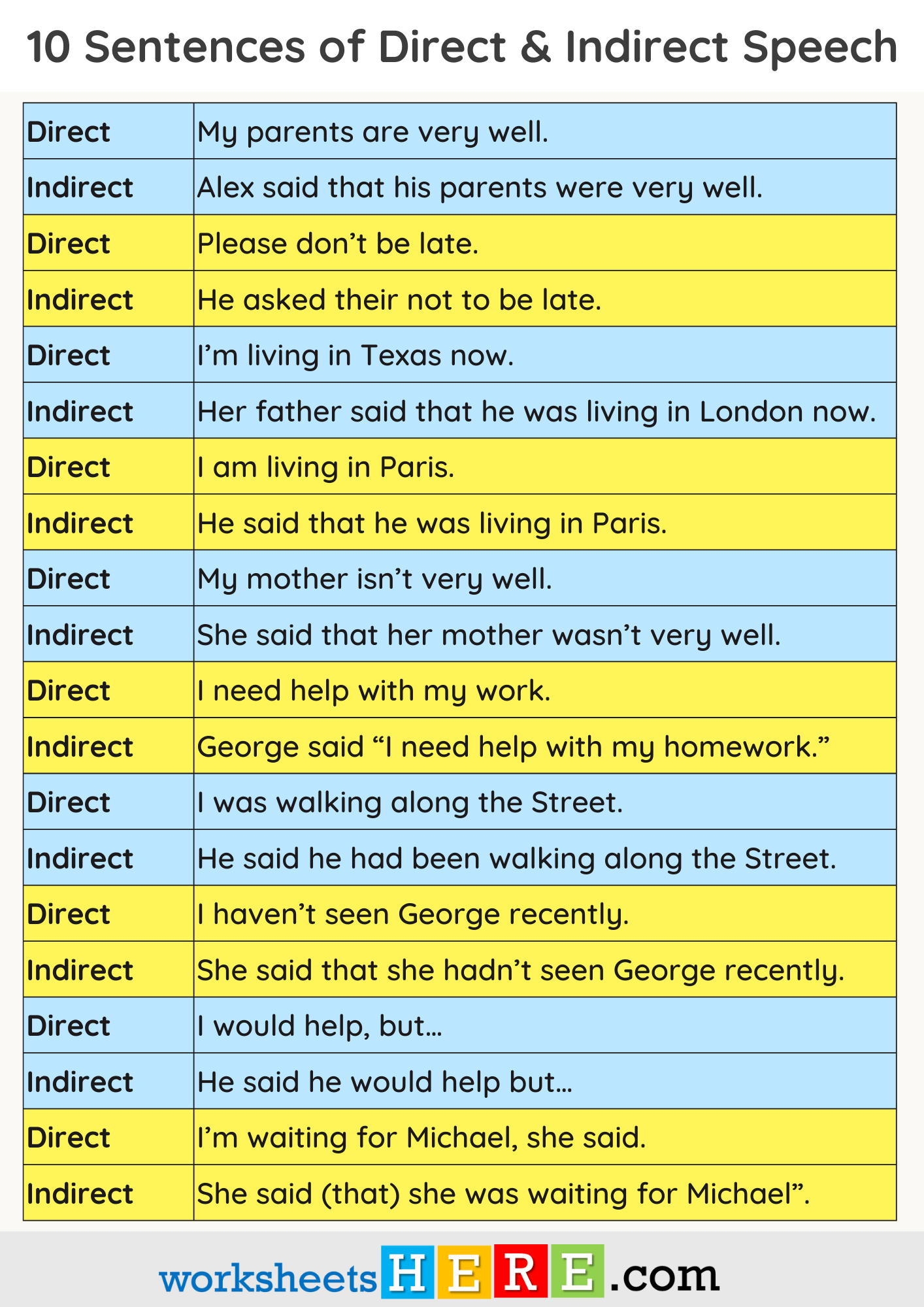
The sheer number of rules and exceptions makes reported speech a challenging area, underscoring the need for structured, repetitive, and varied practice—a need perfectly met by well-designed Direct and indirect speech worksheets.
The Indispensable Role of Direct and Indirect Speech Worksheets
Worksheets serve as the backbone of practical grammar instruction. They provide a structured environment for learners to apply theoretical knowledge, identify patterns, and reinforce rules through repetition. For a complex topic like reported speech, their value cannot be overstated.
Direct and indirect speech worksheets offer:
- Targeted Practice: They isolate specific grammar points, allowing learners to focus solely on the intricacies of tense shifts or pronoun changes without distraction.
- Repetition for Reinforcement: Consistent practice through various exercises helps embed the rules into long-term memory.
- Immediate Application: Learners move from understanding the theory to actively transforming sentences, solidifying their comprehension.
- Self-Assessment: Many worksheets come with answer keys, enabling learners to check their work independently and identify areas needing further attention.
- Variety of Scenarios: Worksheets can present reported speech in different contexts, from simple statements to complex questions and commands, preparing learners for real-world communication.
Types of Effective Direct and Indirect Speech Worksheets
The effectiveness of Direct and indirect speech worksheets lies in their diversity. A good collection will incorporate various exercise types to cater to different learning styles and reinforce different aspects of the rules.
-
Basic Conversion Worksheets (Direct to Indirect & Vice Versa):
- Description: These are the foundational worksheets, presenting sentences in direct speech for conversion to indirect, and vice versa. They typically start with simple statements before progressing to questions, commands, and requests.
- Example:
- Direct: He said, "I am hungry." -> Indirect: He said that he was hungry.
- Indirect: She told me that she had finished her homework. -> Direct: She said to me, "I have finished my homework."
- Benefit: Builds fundamental understanding and automaticity of rule application.
-
Fill-in-the-Blanks Worksheets:
- Description: Sentences are provided with blanks where learners must insert the correct tense, pronoun, or time/place expression for indirect speech.
- Example:
- He told me that he ___ (go) to Paris the next day. (Answer: was going)
- She asked me if I ___ (see) her book. (Answer: had seen)
- Benefit: Focuses on specific rule application, particularly tense backshift and adverbial changes.
-
Error Correction Worksheets:
- Description: Learners are given sentences in indirect speech that contain deliberate errors related to tense, pronouns, or reporting verbs. They must identify and correct these mistakes.
- Example:
- Incorrect: He said he is going to the cinema yesterday.
- Correct: He said he was going to the cinema the day before.
- Benefit: Develops critical thinking and a deeper understanding of the rules by identifying common pitfalls.
-
Multiple Choice Worksheets:
- Description: A direct speech sentence is given, followed by several indirect speech options, only one of which is grammatically correct.
- Example:
- She asked, "Are you ready?"
- a) She asked me if I am ready.
- b) She asked me if I was ready.
- c) She asked me if I had been ready.
- Benefit: Reinforces correct application by contrasting it with common errors, good for quick assessments.
-
Dialogue Transformation Worksheets:
- Description: A short dialogue in direct speech is provided, and learners must rewrite the entire conversation in indirect speech.
- Example:
- Tom: "I’m tired."
- Sarah: "Did you sleep well last night?"
- Tom: "No, I didn’t."
- Transformation: Tom said that he was tired. Sarah asked him if he had slept well the previous night. Tom replied that he hadn’t.
- Benefit: Integrates all rules in a more natural, contextualized setting, preparing for real-life communication.
-
Reporting Verbs Worksheets:
- Description: Focuses specifically on the nuances of different reporting verbs (e.g., ‘suggested,’ ‘demanded,’ ‘offered,’ ‘warned,’ ‘apologized’). Learners choose the most appropriate verb or rewrite sentences using a specific verb.
- Example:
- "Let’s go to the park," he said. -> He ___ going to the park. (Suggested)
- Benefit: Enhances vocabulary and adds sophistication to reported speech.
-
Mixed Exercise Worksheets:
- Description: Combines various types of direct and indirect speech sentences (statements, questions, commands, requests) in a single set of exercises, challenging learners to apply all rules simultaneously.
- Benefit: Simulates real-world language use where different types of reported speech occur interchangeably.
Designing and Utilizing Effective Direct and Indirect Speech Worksheets
For educators creating their own materials or learners selecting resources, certain principles enhance the efficacy of Direct and indirect speech worksheets:
- Gradual Difficulty: Start with simple sentences and isolated rules before combining them. Progress from basic statements to questions, commands, and then to more complex scenarios.
- Clear Instructions: Ensure learners understand exactly what is expected of them for each exercise.
- Contextualization: Whenever possible, use sentences that are meaningful and relatable to the learners’ experiences or current topics of study. Isolated sentences can be less engaging.
- Variety is Key: Don’t stick to just one type of exercise. Mix and match different formats to keep learners engaged and to reinforce rules from multiple angles.
- Provide Answer Keys: Self-correction is a powerful learning tool. Answer keys allow learners to identify and understand their mistakes immediately.
- Encourage Peer Review: Having learners check each other’s work can be beneficial, fostering collaborative learning and discussion.
- Integrate with Communicative Activities: While worksheets are excellent for mechanical practice, true mastery comes from applying the skill in communicative contexts. Use worksheets as a springboard for role-playing, interviews, or retelling stories.
- Focus on Common Pitfalls: Design exercises that specifically target common errors, such as forgetting tense backshift or misapplying pronoun changes.
Benefits of Consistent Practice with Worksheets
The consistent and thoughtful use of Direct and indirect speech worksheets is undeniably one of the most effective strategies for mastering this complex grammatical structure. The benefits extend beyond mere grammatical correctness:
- Enhanced Accuracy: Regular practice significantly reduces errors in tense, pronoun, and adverbial changes.
- Improved Fluency and Naturalness: As the rules become more ingrained, learners can convert speech more quickly and naturally, leading to smoother communication.
- Boosted Confidence: Success on worksheets builds confidence, encouraging learners to use reported speech more frequently in their speaking and writing.
- Deeper Grammatical Understanding: The analytical process involved in completing worksheets fosters a deeper understanding of English sentence structure and the interconnectedness of various grammatical rules.
- Preparation for Advanced Skills: A solid grasp of reported speech is foundational for more advanced language skills, such as summarizing, academic writing, and nuanced conversational exchanges.
- Independent Learning: Worksheets empower learners to take control of their own learning, allowing for self-paced study and targeted review.
Where to Find Direct and Indirect Speech Worksheets
A wealth of resources exists for finding high-quality Direct and indirect speech worksheets:
- Educational Websites: Many reputable ESL/EFL websites offer free printable worksheets, often categorized by level and specific grammar points. Examples include British Council LearnEnglish, ESL-Lounge, and BusyTeacher.
- Textbooks and Workbooks: Traditional grammar textbooks usually include extensive sections and exercises on reported speech.
- Teacher Resource Platforms: Websites like Teachers Pay Teachers offer a vast array of user-created materials, some free and some for purchase, often including complete lesson plans alongside worksheets.
- Online Generators: Some tools allow educators to create customized worksheets by inputting sentences or selecting specific rule sets.
- AI-Powered Tools: Large language models can generate practice sentences and even full worksheets based on specific instructions, though human review is always recommended for accuracy.
Conclusion
Mastering reported speech is a journey that requires both theoretical understanding and extensive practical application. Direct and indirect speech worksheets are the unsung heroes of this journey, providing the structured, repetitive, and varied practice necessary to transform a challenging grammatical concept into a fluent and natural part of a learner’s linguistic repertoire.
By embracing diverse worksheet types, designing them with clear pedagogical principles, and utilizing them consistently, educators can effectively guide their students, and learners can confidently navigate the complexities of recounting conversations. In the pursuit of English language proficiency, the humble worksheet remains an invaluable and indispensable tool.
